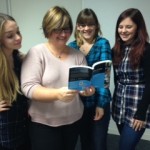 Student midwives spend approximately 50% of their three year undergraduate programme in the clinical area. Going to a new placement is often a stressful time for them as they consider ‘will they fit in’, ‘will they know enough’, ‘have they the right skills’, ‘what will they be able to learn whilst there to meet their practice assessments’ and so on. Other concerns relate to being away from home, what hours they are expected to do and how they cope with ‘difficult’ mentors. If students are unfamiliar with healthcare environments it takes time for them to adjust and become used to the environment. It was these thoughts that began fermenting in my head back in 2010 and following a positive response from students whose views on a book on placements were informally sought, I pitched the idea to a commissioning editor at Wiley Blackwell. In addition wider research had revealed that no such book existed within the published midwifery arena. Finally, in 2012 a contract was agreed between myself, and Margaret Fisher, Associate Professor in Midwifery at Plymouth University to co-edit nine chapters for submission in November 2014. The book is now due for publication on the 11th December 2015.
Student midwives spend approximately 50% of their three year undergraduate programme in the clinical area. Going to a new placement is often a stressful time for them as they consider ‘will they fit in’, ‘will they know enough’, ‘have they the right skills’, ‘what will they be able to learn whilst there to meet their practice assessments’ and so on. Other concerns relate to being away from home, what hours they are expected to do and how they cope with ‘difficult’ mentors. If students are unfamiliar with healthcare environments it takes time for them to adjust and become used to the environment. It was these thoughts that began fermenting in my head back in 2010 and following a positive response from students whose views on a book on placements were informally sought, I pitched the idea to a commissioning editor at Wiley Blackwell. In addition wider research had revealed that no such book existed within the published midwifery arena. Finally, in 2012 a contract was agreed between myself, and Margaret Fisher, Associate Professor in Midwifery at Plymouth University to co-edit nine chapters for submission in November 2014. The book is now due for publication on the 11th December 2015.
Professor Paul Lewis wrote the forward and chapter contributions from Bournemouth University lecturers, Dr. Sue Way, Stella Rawnson and myself, prepare prospective and current students for midwifery practice and the profession, caseloading and the elective period. Jo Coggins and Henrietta Otley, both midwives practising in North Wiltshire were co-opted to write chapters on ‘Preparing for practice’ and ‘Low-risk midwifery placements’. Other chapters were written by Margaret Fisher and Faye Doris at Plymouth University.
The final published edition is small enough to fit into a uniform pocket and contains many vignettes from students currently or previously studying at Bournemouth and Plymouth University. Their stories reflect ‘real life’ clinical experience and ‘Top Tips’ provide overall advice. Three original cartoons illustrating the vagaries of placement were devised by Clare Shirley (formerly a BU student, now a newly qualified midwife) and Hugo Beaumont (4th year medical student at Plymouth University). Students and women have provided photographs. Both Margaret and I hope students far and wide will enjoy the book which aims to provide a realistic perspective on clinical placement, by offering hints and tips and encouragement along their student journey.
Category / Featured academics
Dr. Fiona Kelly invited guest speaker at Cecily Saunders Institute, King’s College London
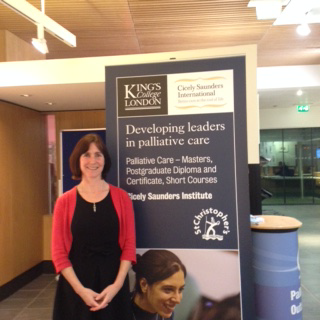 On 25th November, Dr Fiona Kelly attended the Cecily Saunders Institute at King’s College London as an invited guest speaker to present research on determining what aspects of the design of care environments might be important for people with dementia nearing the end of life. The key messages of her presentation were the importance of firstly assuming the ability of people with dementia to engage with the senses, whether through touch, sound, smell, sight or taste and then to provide the means of engaging with whatever sense was appropriate or possible. The presentation was followed by a panel discussion with the audience in which the practical application of design principles within hospital settings was debated. The consensus was that even small changes can make a big difference. Following the presentation and discussion, the panel made a commitment to include consideration of dementia design principles in staff education within the Institute.
On 25th November, Dr Fiona Kelly attended the Cecily Saunders Institute at King’s College London as an invited guest speaker to present research on determining what aspects of the design of care environments might be important for people with dementia nearing the end of life. The key messages of her presentation were the importance of firstly assuming the ability of people with dementia to engage with the senses, whether through touch, sound, smell, sight or taste and then to provide the means of engaging with whatever sense was appropriate or possible. The presentation was followed by a panel discussion with the audience in which the practical application of design principles within hospital settings was debated. The consensus was that even small changes can make a big difference. Following the presentation and discussion, the panel made a commitment to include consideration of dementia design principles in staff education within the Institute.
Fleming, R., Kelly, F. and Stillfried, G. (2015) ‘I want to feel at home’: establishing what aspects of environmental design are important to people with dementia nearing the end of life, BMC Palliative Care. http://www.biomedcentral.com/1472-684X/14/26
Dr. Dinusha Mendis disseminates Government-funded research on the IP implications of 3D Printing at invited talks in UK and EU (Part II)
In April 2015, the UK Intellectual Property Office (UKIPO) published three reports reflecting a legal and empirical study into the intellectual property (IP) implications of 3D printing. The project – commissioned by the UKIPO – was awarded to Bournemouth University and was led by Dr. Dinusha Mendis.
Together with Dr. Mendis, the research team consisted of Dr. Davide Secchi (Southern University, Denmark; previously Bournemouth University at the time of conducting the research) and Dr. Phil Reeves (Econolyst Ltd – now Stratasys Strategic Consulting Ltd).
All three reports can be found here and further information about the project, including research findings and recommendations for the UK Government, Industry and Intermediaries can be found here.
Since the publication of the reports, Dr. Dinusha Mendis, Co-Director of the Centre for Intellectual Property Policy and Management (CIPPM) has been invited to deliver a number of talks in UK and Abroad, thereby reflecting the impact of the research.
This blog-post, highlights the invited talks in EU. For the dissemination of research in UK, please see here.
34th ECTA Conference, Hamburg, Germany
On 12 June 2015, Dr. Mendis was invited to present the research at the European Communities Trade Mark Association 34th Annual Conference in Hamburg. The Conference took place from 10-13 June 2015 and Dr. Mendis spoke on the copyright implications of 3D printing based on the findings from the UKIPO project.
Dr. Mendis spoke on the topic as part of a Panel exploring the challenges to copyright law, which also included Professor Ian Hargreaves, Professor of Digital Economy, Cardiff University UK and author of the Hargreaves Review 2011.
For further information, please see here.
MAPPING Project, First General Assembly, Hannover, Germany
From 22-23 September 2015, the First General Assembly of the FP7-funded MAPPING Project was held in Hannover, Germany at the Hannover Congress Centrum.
MAPPING – Managing Alternatives for Privacy, Property and Internet Governance brought together stakeholders from three key areas including Internet Governance, Privacy and Intellectual Property.
Dr. Mendis was invited to speak in the Intellectual Property Panel titled ‘The EU IP Reform: Unlocking Culture, Stimulating Progress’. As part of the talk, Dr. Mendis was invited to speak on the UKIPO 3D Printing project.
Further information about the event can be found here.
OHIM Enforcement Conference, Alicante Spain
In November (18-20 November 2015) Dr. Mendis was invited by the Office for Harmonisation in the Internal Market (OHIM) in Alicante Spain. The 3-day event organised by OHIM, Europol and Eurojust explored issues on tackling enforcement in relation to the infringement of copyright and design law.
The event was attended by policy makers, law makers, customs and border protection officials, investigators, criminal analysts and industry experts amongst others.
Dr. Mendis presented at this conference together with with Dr. Davide Secchi (co-author of Study 1 of the UKIPO Project) and member of the research team which carried out the Commissioned work for the UKIPO.
Dr. Mendis and Dr. Secchi presented the research carried out particularly for Study 1 of the UKIPO project, but also took the opportunity to speak on next steps and future projects – in taking forward the UKIPO Project.
In this regard, Dr. Mendis spoke briefly about the work being carried out for the newly funded project considering a legal and empirical case study on 3D printing, 3D scanning and mass customisation of ancient and modern jewellery.
For more information about the new project, please see here. For further information about OHIM’s event, please see here.
FORUM Institut Management GmbH, 3D Printing and IP, Munich, Germany
On 1 December 2015, FORUM Institüt fur Management GmbH hosted an international conference exploring 3D Printing and IP Rights. The conference brochure including further details and speakers can be found here.
Dr. Mendis was invited to speak on the UKIPO Project with a particular focus on the implications for IP as a result of 3D online platforms as well as its impact on the industrial sector.
The presenters were drawn from industry, professional practice and academia thereby providing for a vibrant discussion.
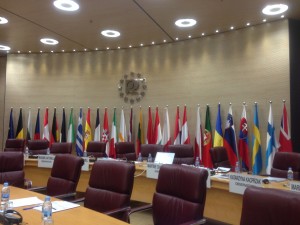
Dr. Dinusha Mendis disseminates Government-funded research on the IP implications of 3D Printing at invited talks in UK and EU (Part I)
In April 2015, the UK Intellectual Property Office (UKIPO) published three reports reflecting a legal and empirical study into the intellectual property (IP) implications of 3D printing. The project – commissioned by the UKIPO – was awarded to Bournemouth University and was led by Dr. Dinusha Mendis.
Together with Dr. Mendis, the research team consisted of Dr. Davide Secchi (Southern University, Denmark; previously Bournemouth University at the time of conducting the research) and Dr. Phil Reeves (Econolyst Ltd – now Stratasys Strategic Consulting Ltd).
All three reports can be found here and further information about the project, including research findings and recommendations for the UK Government, Industry and Intermediaries can be found here.
Since the publication of the reports, Dr. Dinusha Mendis, Co-Director of the Centre for Intellectual Property Policy and Management (CIPPM) has been invited to deliver a number of invited talks in UK and Abroad, thereby reflecting the impact of the research.
This blog-post highlights the invited talks in UK. For dissemination of research in the EU, please see here.
Plymouth Law School, One Day Workshop on CSR
On 28 August 2015, Plymouth Law School held a one-day workshop, titled, ‘Valuing Knowledge, Creativity and Innovation: Relating Corporate Social Responsibility to Copyright Law’.
The workshop considered the prospect of practising Corporate Social Responsibility (CSR) in relation to copyright, where similar ideas of corporate social awareness have already applied to other areas of intellectual property protection.
Dr. Mendis explored the issue from the angle of emerging technologies and gave a presentation titled ‘Printing the Future: Is there a Need for Regulation? The Copyright Implications of 3D Printing’.
Other invited speakers on the day included, amongst others, Professor Charlotte Waelde, Professor of Intellectual Property, Exeter University and Dr. Abbe Brown, Reader and Deputy Head of the Law School, University of Aberdeen.
Please see here for further information.
EPIP Conference 2015, CREATe, University of Glasgow
From 2-3rd September 2015, CREATe, the RCUK Centre for Copyright and New Business Models in the Creative Economy at the University of Glasgow hosted the 10th Annual Conference of European Policy for Intellectual Property (EPIP). The event explored intellectual property from an economic, legal and political perspective considering its impact in the creative economy with a focus on copyright, data and the changing economics of the digital world.
Dr. Mendis presented and led a panel titled ‘A Legal and Empirical Study into the Intellectual Property Implications of 3D Printing – Findings, Conclusions and Recommendations’. The panel consisted of the research team, which carried out the research for the UKIPO Project, with a Panel member from the UKIPO outlining the next steps in relation to policy in the area of 3D printing and IP Law.
Together with Dr. Mendis, other Panel members included Dr. Davide Secchi (University of Southern Denmark), Ms. Sophie Jones (for Dr. Phil Reeves) (Stratasys Strategic Consulting) and Ms. Pippa Hall of the UK Intellectual Property Office.
Further information this event can be found here and further information about the conference including presentations from both days can be found here.
IPAN Event, London
On 11 November 2015, the Intellectual Property Awareness Network (IPAN) hosted an evening event, which explored 3D printing from an industry perspective as well as from a legal (IP) perspective. IPAN is a non-profit organisation working to improve understanding of patents, trademarks, designs, copyright and other IP rights and their value to society.
IPAN is chaired by CIPPM Associate Director, Professor Ruth Soetendorp.
Dr. Mendis was invited to deliver a talk highlighting the research findings, conclusions and recommendations of the UKIPO Project and its implications for IPAN’s membership. Dr. Mendis spoke alongside Mr. Paul Gately, EMEA Manager of 3D Systems.
3D Printing Panel and Poster Presentation at University of Liverpool
On 11 December 2015, Dr. Mendis will form part of a panel exploring the topic of 3D printing and its implications for IP law, from a broader perspective at the University of Liverpool.

BU Research Project wins THE Award
 Congratulations to the SHIVA Project team who won the Times Higher Education (THE) Award in the Outstanding Innovation in Teaching or Research category.
Congratulations to the SHIVA Project team who won the Times Higher Education (THE) Award in the Outstanding Innovation in Teaching or Research category.
The SHIVA Project (Scuplture for Healthcare: Interaction and Visual Art in 3D) won the award at the THE Awards, one of the most prestigious awards in the Higher Education sector.
The team from BU’s National Centre for Comptuer Animation (NCCA) developed the SHIVA software system, working with Victoria Education Centre in Dorset – a local school for children with physical and learning disabilities.
The software enables students to bring art to life by creating objects using eye gaze or touchscreen technology, before 3D printing the finished result.
The winning team for the award included: Professor Alexander Pasko, Professor Peter Comninos, Dr Leigh McLoughlin, Dr Oleg Fryazinov, Dr Valery Adzhiev, PhD student Mathieu Sanchez and Mark Moseley, who worked for Victoria Educational Centre and is now a BU Doctoral student.
To view all the winners from the evening, visit the THE Awards website.
Robust Semi-supervised Nonnegative Matrix Factorization
We would like to invite you to the latest research seminar of the Creative Technology Research Centre.
Speaker: Jing Wang
Title: Robust Semi-supervised Nonnegative Matrix Factorization
Time: 2:00PM-3:00PM
Date: Wednesday 2nd December 2015
Room: P302 LT, Poole House, Talbot Campus
Abstract: Clustering aims to organize a collection of data items into clusters, such that items within a cluster are more “similar” to each other than to those in the other clusters, which has been used in many fields, including machine learning, pattern recognition, image analysis, information retrieval, and bioinformatics. Clustering is usually performed when no information is available concerning the membership of data items to predefined classes. For this reason, it is traditionally seen as part of unsupervised learning. However, in reality, it is often the case that some data information (e.g. labels) is available and could be used to bias the clustering for producing considerable improvements in learning accuracy. Also, data have some new challenges, such as high- dimensionality, sparsity, containing noises and outliers, etc. This motivates us to develop new technology to deal with this kind of complex data. To address all these issues, we propose semi-supervised nonnegative matrix factorization approaches. Experiments carried on well-known data sets demonstrate the effectiveness.
We hope to see you there.
COST Actions – supporting high-risk, innovative and emerging research themes
COST Actions are a flexible, fast, effective and efficient networking instrument for researchers, engineers and scholars to cooperate and coordinate nationally funded research activities. COST Actions allow European researchers to jointly develop their own ideas in any science and technology field. COST Actions are bottom-up science and technology networks, open to researchers and stakeholders with a duration of four years. They are active through a range of networking tools , such as workshops, conferences, training schools, short-term scientific missions (STSMs), and dissemination activities. COST does not fund research itself.
COST prides in its support for high-risk, innovative and emerging research themes. Importantly, COST does not set any research priorities. 
Currently on the COST website is a report on Collecting research data to counter femicide worldwide
Femicide across Europe is the first pan-European research network investigating the causes and risk factors of a phenomenon killing thousands of women every year, worldwide.
Femicide refers to the killing of women and girls because of their gender. European researchers studying the cultural, societal and psychological causes and risks factors behind femicide set up the network to fight the phenomenon through advocacy and research. One idea is to create a European Femicide Observatory gathering and comparing data from each of the 30 countries involved, of which half are Inclusiveness Target Countries . The goal is to come up with new guidelines and shape new EU public policies countering killings.
Specialists have been studying quantitative and qualitative data and ways to reduce discrepancies in country records. Such discrepancies are often due to the different definitions of femicide, which is sometimes seen as gender-based violence.
“When our COST Action was first proposed, the term femicide was not widely used. Everyone knew of homicide, but few had given thought to the fact that some women, particularly those involved in intimate relationships, were murdered simply because they were women. Today, two years within the COST Action, ‘femicide’ has become a buzzword, Action Chair Dr Shalva Weil explains.“
Network members have also been advocating for a more straightforward approach to lowering femicide rates in Europe. They have already addressed the Portuguese Parliament and the Parliament of Aragon in Spain. The network also took part in two United Nations sessions in Bangkok (November 2014) and New York (October 2015).
By participating in the network’s training schools and scientific exchanges, young researchers are also given the chance to better understand the phenomenon EU-wide. One outstanding result of the Action’s work is a comparison of national statistics from 10 European countries .
The Action’s next annual meeting will take place in Ljubljana, Slovenia, in May 2016.
Why not take a look at the COST Action database to see if there is a current Action relating to your research? You can then consider joining an existing Action or submitting your own proposal.
Click on the tag COST Action (below) to see other BU posts on this topic, including Edwin van Teijlingen’s report on his recent publication and his experience of attending a COST Action Training School.
If you are interested in applying for COST, please contact Emily Cieciura, Research Facilitator: EU & International of you Faculty’s Funding Development Officer.
‘Vulnerable Warriors: Counter-terrorism and the rise of Militarised Policing’ seminar by Dr Anna Feigenbaum and Daniel Weissman,
Dr Anna Feigenbaum
Daniel Weissman
2nd December 2015, Royal London House, R303, 1-1:50 pm
All staff and students welcome to the last Social Science seminar in 2015.
Abstract:
This paper seeks to better understand the cultural and material processes of police militarization and its relationship to security infrastructures and geo-political practices of social control. In this paper we trace the rise the ‘Warrior Cop’ through an analysis of changes in the circulation of advertisements of policing and policing products at security expose between the late 1990s and the present, taking our analysis up through the recent Paris attacks and the Milipol Security expo held days after.
This analysis is framed against the backdrop of existing research on the shift in the post-Cold War period from a security focus on the threat of the nation-state to the threat of insurgency and non-state actors. This period was characterized by national and transnational changes to policing: intelligence gathering and information sharing, as well as equipment supply and transfer and knowledge exchange around training and operations.
We begin this paper with an overview of the key shifts in the military and policing sectors that gave rise to the phenomenon of ‘Warrior Cops’. In contrast to dominant narratives of police militarisation that see power and tactics shift directly from the military to the police, we outline what we refer to as the militarization of security, a process through which not only the police, but also judicial and emergency response services, infrastructures, feelings and attitudes become transformed in ways that position the need for warriors against the threat of risky spaces and vulnerable bodies.
For any enquiries regarding the Social Science seminar series please contact Dr Mastoureh Fathi: mfathi@bournemouth.ac.uk
Professor Elizabeth Rosser elected to the Board of Directors of Sigma Theta Tau International
Congratulations to Professor Elizabeth Rosser, who has been elected to the Board of Directors of the prestigious nursing society Sigma Theta Tau International (STTI). Elizabeth is only one of two members on the STTI Board from outside of the USA. The Board is small with only 10 members in total.
Founded in 1922 STTI recognises the value of leadership, scholarship and excellence in nursing practice. In 1936, STTI became the first U.S. organization to fund nursing research. Today, STTI supports these values through its numerous professional development products and services that focus on the core areas of education, leadership, career development, evidence-based nursing, research, and scholarship.
Elizabeth was elected to the STTI Board at the 43rd Biennium of Sigma Theta Tau International in Las Vegas where she was representing the Phi Mu Chapter (England) as President. It is fitting recognition for Elizabeth’s work in establishing and leading the All England Chapter.
CIPPM Project Copyrightuser.org wins AHRC Research in Film Award
An animated film on Copyrightuser.org titled The Adventure of the Girl with the Light Blue Hair won an AHRC Research in Film Award on 12 November 2015 at an Awards Ceremony hosted at the British Film Institute, Southbank London.

Copyrightuser.org is an online resource, which makes copyright law accessible to creators, teachers, students and members of the public. The project began with Bournemouth University’s Fusion Investment Fund in 2012 after which, the project has been successfully funded by RCUK/AHRC since 2013.
It is a collaborative project carried out by the Centre for Intellectual Property Policy and Management (CIPPM) Bournemouth University and CREATe, University of Glasgow.
The animated film was short-listed for the AHRC 10th Anniversary Research in Film Award within the category Award for Innovation in Film – Best Film in the Year and beat another four contenders to win the award.
The panel of judges – consisting of industry and academic experts such as film director Beeban Kidron, Financial Times Arts Editor Jan Dalley, and actor and producer Diana Quick – described the film as “a well-constructed, quality animation addressing issues of creativity, IP and copyright for schools and undergraduates: lively, engaging, witty (à la Sherlock Holmes mode), informative and educating at the same time.”
The Adventure of the Girl with the Light Blue Hair is the first episode of The Game is On!, web series and is produced by Mr. Bartolomeo Meletti (CREATe, University of Glasgow) and Professor Ronan Deazley (Queens University Belfast). The film draws inspiration from Sherlock Holmes and other well-known copyright and public domain works and provides a springboard for exploring various copyright concepts.
It forms part of a suite of online learning materials for students and teachers in the UK while educating the wider public about what can and cannot be done with copyright works. To achieve this aim, researchers working on Copyrightuser.org produced both video and textual material.
The animated film is enhanced by 12 ‘Case Files’ authored by Ms. Hayleigh Bosher and Dr. Dinusha Mendis (CIPPM, Bournemouth University), which draws on the various elements of the film to explore key principles and ideas underpinning copyright law, creativity, and the limits of lawful appropriation and reuse.
The educational materials also include Copyright for A Level Media Studies authored by Ms. Hayleigh Bosher and Dr. Dinusha Mendis (CIPPM, Bournemouth University) – an educational web resource which addresses the AS/A Level Unit Critical Perspectives in Media, Section B: Contemporary Media Issues.
The AHRC Research in Film Awards is designed to recognise the creative and innovative work being undertaken at the interface between research and film. All the winners and full versions of the films can be seen here.
Talk by Dr Stephanie Schwandner-Sievers cancelled
Unfortunately we are cancelling the talk: Ethnographies of Memory – the cultural reproduction of militancy in Kosovo by Dr Stephanie Schwandner-Sievers. We apologise for the late notice. This is because the Women Academic Network talk has been rescheduled this morning for the same time slot (see below). Dr Schwandner-Sievers will give her talk at a later date to avoid some people having to make a choice.
Polly Trenow (Fawcett Society)
‘Feminism in practice – does activism really work?’
Wednesday 18th November
TAG22
2-4pm (with networking 3-4pm)
For any questions, please get in touch with Dr Masi Fathi (mfathi@bournemouth.ac.uk)
TetraGrip: A functional electrical stimulation (FES) device for restoring hand and arm functions in people with spinal cord injuries
We would like to invite you to the latest research seminar of the Creative Technology Research Centre.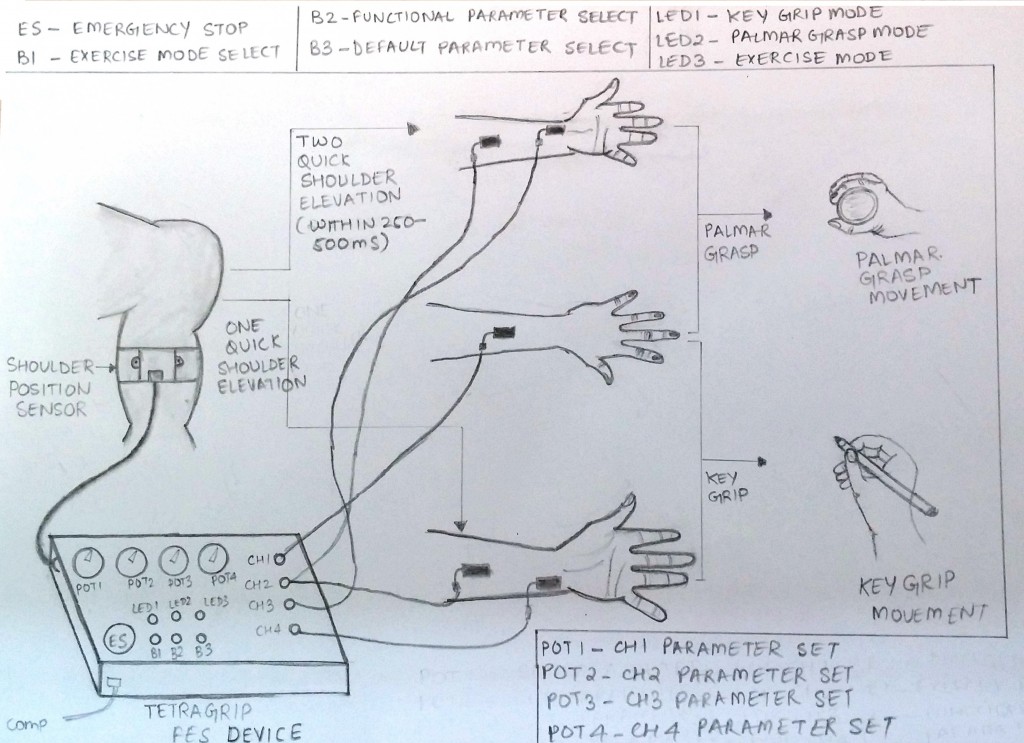
Speaker: Lalitha Venugopalan
Lalitha is a Bournemouth University Creative Technology postgraduate student researching for a PhD in Biomedical Engineering based at the Salisbury NHS Foundation Trust.
Title: TetraGrip: A functional electrical stimulation (FES) device for restoring hand and arm functions in people with spinal cord injuries
Time: 2:00PM-3:00PM
Date: Wednesday 18th November 2015
Room: P302 LT, Poole House, Talbot Campus
Abstract:
TetraGrip is a four channel upper limb FES device for restoring the hand and arm functions on people with C5-C7 tetraplegia. This device uses an inertial measurement sensor (IMU) for detecting the shoulder elevation/depression. The signal from the IMU is used for controlling the functions of the stimulator and for adjusting the grasp strength.
The stimulator is programmed to operate in the following modes: exercise, key grip and palmar grasp. Key grip mode (fig 1) is used to grasp smaller objects like a pen or a fork, whereas the palmar grasp (fig 2) is used to grasp larger objects like a glass. The exercise mode is used to strengthen the forearm muscles.
The system will be clinically tried on ten able bodied volunteers to evaluate the repeatability and reproducibility. If the results from this study are found to be satisfactory, then the device will be clinically tried on tetraplegic volunteers for answering the following questions:
- Is possible for a person with tetraplegia to generate the desired input signal to control the operation of the device?
- Does the system improve the hand and arm functions of the user?
- Is the system easy to use for people with tetraplegia?
We hope to see you there.
Hello from an up and coming researcher, Dr. Choe :)
Hello BU Researchers:
This is Jaeyeon Choe, your new colleague originally from Gangnam, South Korea. After earning my Ph.D. at The Pennsylvania State University, USA, and working in China and Macau, I have joined BU as a Senior Lecturer in Events & Leisure, Faculty of Management. My primary research areas are Spiritual/Religious Tourism, and Chinese Consumer Behavior. Recently, I presented the papers, “Tourism development and its impact on Filipino workers’ quality of life in Macao, China” at Ethnicity and Tourism conference in Chiang Mai, Thailand; and “Chinese consumer behavior: conspicuous consumption at an international wine festival in Dalian, China” at Consumer Behavior in Tourism Symposium in Bruneck, Italy.
I am also currently finishing up a funded study, ‘Tourism development and cross-cultural understanding of quality of life among local residents, skilled and unskilled immigrant workers in Macao, China’ that was granted by Institute for Tourism Studies, Macao. I am preparing for another project on spiritual tourism among westerners in South East Asia, utilising an affiliation with the Centre for Asian Tourism Research at Chiang Mai University, Thailand. It is planned for the summer of 2016, which I am really looking forward to it.
My publications are available on BRIAN. I look forward to many interesting research activities and collaboration across BU! 🙂
https//twitter.com/choe_jaeyeon
Fear in childbirth: is the media responsible?

The media are often blamed for influencing society’s attitudes and views. In this month’s Café Scientific we will debate the impact of the mass media on women’s views of childbirth. The motion is: “Fear in childbirth: is the media responsible?”
Café Scientific is being hosted at Café Boscanova in Bournemouth on November 3rd at 19.30. The debate is open to the general public. It will be chaired by Prof. Vanora Hundley, Professor of Midwifery and the two proponents on either side of the debate are Dr. Ann Luce and Prof. Edwin van Teijlingen. Ann Luce is a well recognised media researcher and a Senior Lecturer in Journalism and Communication. Edwin van Teijlingen is a medical sociologist and Professor of Reproductive Health Research.
The debate will touch upon social perceptions and beliefs about childbirth can increase women’s requests for interventions, such as caesarean section, with long-term health implications for mothers and babies. This month’s Café Scientific will explore the role of the mass media in shaping these beliefs and identify whether media portrayals are responsible for rising rates of intervention.
Join us for an interactive debate on the impact of the mass media on women’s views of childbirth. The audience will be given the opportunity to vote on the motion before and after the debate.
These academics have written a paper on the topic of debate, a copy of which can be found here!
Congratulations to Prof. Brooks
BU Professor Ann Brooks has been made a Fellow of the Academy of Social Sciences (FAcSS).
Ann Brooks is Professor of Sociology at Bournemouth University since January 2015. Ann has held senior positions in universities in Singapore, Australia and New Zealand and has held visiting fellowships and scholarships in Singapore and the USA. She was a Visiting Professor at the Institute of Health and Community at Plymouth University in 2014 and was previously a Senior Visiting Research Fellow at the Asia Research Institute, National University of Singapore and a Visiting Scholar in the Department of Sociology at the University of California, Berkeley. She is author of Academic Women (Open University Press, 1997); Postfeminisms: Feminism, Cultural Theory and Cultural Forms (Routledge, 1997); Gender and the Restructured University (Open University Press, 2001); Gendered Work in Asian Cities: The New Economy and Changing Labour Markets (Ashgate, 2006); Social Theory in Contemporary Asia (Routledge, 2010); Gender, Emotions and Labour Markets: Asian and Western Perspectives (Routledge, 2011) and Emotions in Transmigration: Transformation, Movement and Identity (Palgrave 2012) (with Ruth Simpson). Recent books include: Consumption, Cities and States: Comparing Singapore with Cities in Asia and the West (Anthem Press, 2014) (with Lionel Wee); Popular Culture, Global Intercultural Perspectives (Palgrave, 2014); and Emotions and Social Change: Historical and Sociological Perspectives (Routledge, New York, 2014) (edited with David Lemmings). Her latest book is: Genealogies of Emotions, Intimacies and Desire: Theories of Changes in Emotional Regimes from Medieval Society to Late Modernity (2016 Routledge, New York).
Further information on this year’s new Fellows can be found here!
Congratulations!
Prof. Edwin van Teijlingen
The use of VectorPixels to represent Photographic images
We![]() would like to invite you to the latest research seminar of the Creative Technology Research Centre.
would like to invite you to the latest research seminar of the Creative Technology Research Centre.
Speaker: Alain Simons
Alain is new lecturer at Bournemouth University, teaching on the Games Technology/Games Programming courses, and this is an opportunity to learn about his PhD research.
Title: The use of VectorPixels to represent Photographic images
Time: 2:00PM-3:00PM
Date: Wednesday 28th October 2015
Room: P302 LT, Poole House, Talbot Campus
Abstract: Photographic images are represented by a grid of pixels. Each pixel has a colour value (3 different ones for RGB colour Images) so that computations are very easy to do. However the number of pixels that are available is increasing at a faster rate every year. Images also need to be transported as in every other digital information. Two problems are arising with the growing amount of pixels. How can 4K images will be transported over the internet? How long will it take to compute 8K images? Those questions are tackled for the moment with better compression techniques and faster CPUs, but they have their limits. VectorPixels want to start from scratch, a new approach, a new algorithm to visualize images on screen. No hardware is available at the moment to capture VectorPixels so for creating VectorPixels ordinary pixel information will be used. Our algorithm is made up of three components namely trace, calculate and save. A VectorPixel is a vector based pixel as the word itself indicates.
We hope to see you there.
BU Dr Zulfiqar Khan (Associate Professor) International Esteem
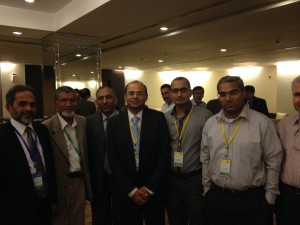
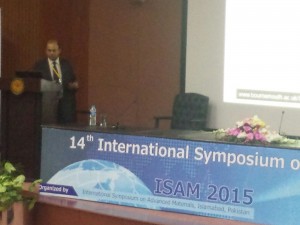
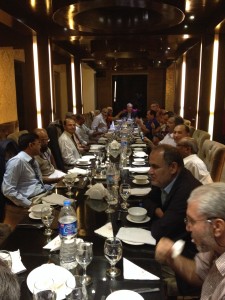
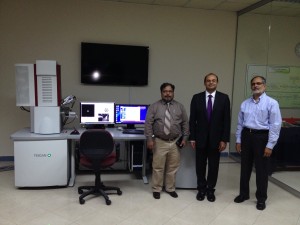
Dr Zulfiqar Khan was recently selected by invitation by the Pakistan President’s Highly Qualified Professionals (HQPs) Programme, part of PPQP, managed and administered by the Ministry of Federal Education & Professional Training Government of Pakistan.
This programme funded Zulfiqar’s participation in the 14th International Symposium on Advanced Materials Oct 2015 held at National Centre for Physics Islamabad as invited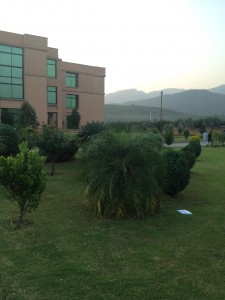 speaker and guest speaking at key universities and research institutes.
speaker and guest speaking at key universities and research institutes.
This conference is held every two years and has been successfully running for the last 28 years. This conference attended by high profile researchers from Bangladesh, China, Egypt, Germany, Japan, Jordan, Malaysia, Pakistan, Saudi Arabia, Singapore, Serbia, Turkey, UK (Bournemouth and Leeds) and US. The conference provided and excellent platform for disseminating latest research findings, exchange of ideas, networking and initiating research collaborations.
Zulfiqar presented latest findings in Surface Engineering through nano coatings (thin films 300-400 nm and up to 5 μm) incorporating corrosion. This research is conducted at the Sustainable Design Research Cluster with PGRs (Parisa Pashaei, Rizwan Bajwa and Hammad Nazir).
He also led the discussion panel on Surface Engineering & Ceramics as Panel Chair.
The Federal Minister for Planning, Development & Reform Professor Ahsan Iqbal spoke at the closing ceremony of the 14th International Conference on Advanced Materials ISAM 2015. He informed the conference delegates on the Government strategy for research & development.
This programme also included Zulfiqar’s invited guest speaking at key Universities and research institutes as Institute of Space Technology, National Institute of Vacuum Science & Technology NINVST, National Centre for Physics NCP and National University of Sciences & Technology NUST. He also held meetings with key staff including DG NINVAST, Director NCP, Deans NUST Mechanical and Chemical & Manufacturing Engineering, Rector GIK (Ghulam Ishaq Khan Institute of Engineering Sciences & Technology), researchers and students.
His participation in the ISAM 2015 and invited guest speaking has provided a platform for incubating international research and education collaborations and promoting BU as an international leader in nano materials & corrosion research.
Public engagement success – Biology Week in local school receives thousands of visitors
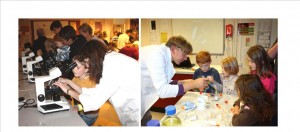
Saturday 10th – Sunday 18th October saw the celebration of Biology Week nationwide. To join the celebrations Genoveva Esteban and Daniel Franklin from the Department of Life and Environmental Sciences (SciTech) took part in the Family Festival of Science on 10th October at the Thomas Hardye School (Dorchester), which was attended by over 1,500 visitors. Drs Esteban and Franklin organised two hands-on activities: Organisms that light up their world (funded by the Royal Society of Biology), with help from Wei-Jun Liang (Scitech) and his students who prepared some amazing glowing bacteria; and Ecology under the Microscope (funded by the British Ecological Society), showing how food chains work. Visitors came from far and near…Stroud Valley, Oxford, Devizes, Cranborne, Lyme Regis, Bournemouth, Wimborne, Portland, Sherborne and, of course, Dorchester. Visitors’ age ranged from babies in arms up to Year 12 helpers aged 17 and beyond to great grandparents. A very busy but tremendous day for everyone involved. Special thanks go to Mrs Judith Wardlaw, other staff at Thomas Hardye School and to all the 6th Formers that helped on the day.
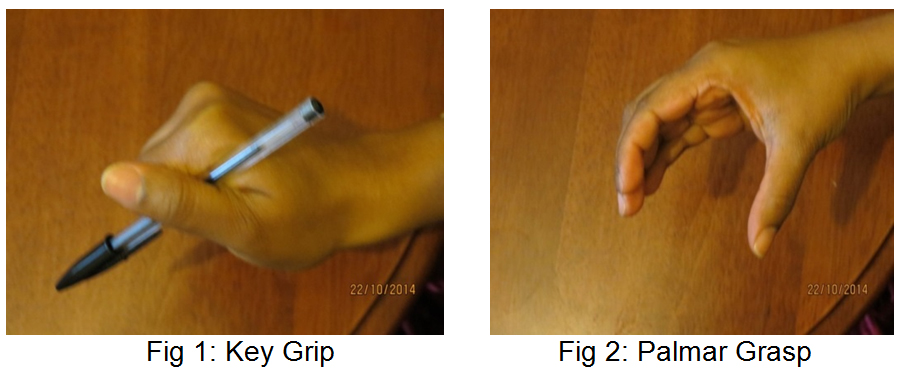
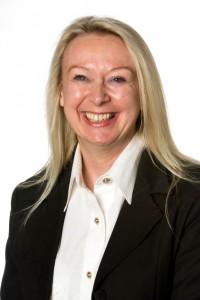











 FHSS academics teaching in Nepal
FHSS academics teaching in Nepal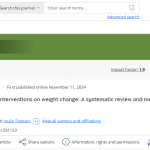 New weight change BU paper
New weight change BU paper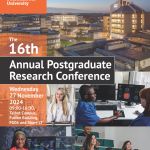 One week to go! | The 16th Annual Postgraduate Research Conference
One week to go! | The 16th Annual Postgraduate Research Conference Geography and Environmental Studies academics – would you like to get more involved in preparing our next REF submission?
Geography and Environmental Studies academics – would you like to get more involved in preparing our next REF submission?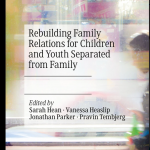 Congratulations to three former BU staff
Congratulations to three former BU staff MSCA Staff Exchanges 2024 Call – internal deadline
MSCA Staff Exchanges 2024 Call – internal deadline Applications are now open for 2025 ESRC Postdoctoral Fellowships!
Applications are now open for 2025 ESRC Postdoctoral Fellowships! Horizon Europe – ERC CoG and MSCA SE webinars
Horizon Europe – ERC CoG and MSCA SE webinars MaGMap: Mass Grave Mapping
MaGMap: Mass Grave Mapping ERC grants – series of webinars
ERC grants – series of webinars